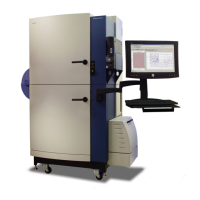FLIPR
®
Tetra High Throughput Cellular Screening System User Guide
0112-0109 H 79
Analysis Process
The Analysis process is included in all protocols, and is always the
second process after Settings.
In the sections below:
• Data viewing options on the Analysis process page are covered
in Viewing Data on page 79.
• Grouping and Correction are explained in Analyzing Data on
page 87.
• Auto-Export is covered in Exporting Data on page 99.
Viewing Data
Acquired data can be viewed in ScreenWorks Software on the main
Analysis process page, in the Multi-Well Graph, or in larger Detail
Graph. The options are described in this section.
Multi-Well Graph
The major part of the Analysis process page consists of a grid
representing the wells of the read plate used in the protocol or data file
(for example, with 96, 384, or 1536 wells). This is called the
Multi-Well Graph. For protocol files this graph is empty, as no data
have been acquired, but in data files each cell of the graph has a trace
of one of the measurements taken from the corresponding read plate
well. The maximum and minimum RLU values of the displayed data are
reported above the Multi-Well Graph.
The Multi-Well Graph displays, for each well represented, one trace of
relative light units (RLUs) versus time. If two or more read modes were
recorded, select the mode to view from the display list box above the
graph. To see the ratio of two read modes, enable Ratiometric
Options in the Configure Corrections > Corrections dialog, and
select Ratio in the display list.
The Read Mode defined in the Multi-Well Graph is also applied to any
traces displayed in the Detail Graph.
The traces displayed in the Multi-Well Graph can be adjusted by the
application of different data-correction options available in the
Correction dialog, for example, the traces can be scaled relative to the
average positive control response (see Correction on page 92).
If groups have been defined for the assay, wells in the Multi-Well Graph
are color-coded to represent these (see Grouping on page 88). In
addition, there is the option to include the kinetic reduction value below
each well trace in the Multi-Well Graph.
Buttons, just above the Multi-Well Graph, open dialogs that offer
various data analysis options; some relevant to protocol set up, some
to already-acquired data in data files, and some to both. Multi-Well
Graph buttons and descriptions include:

